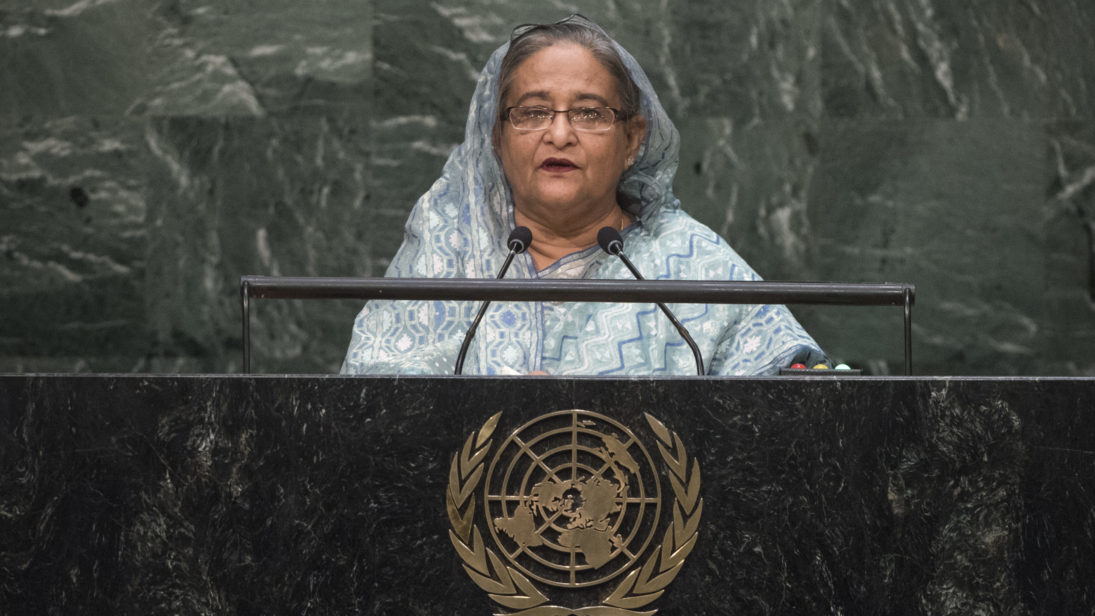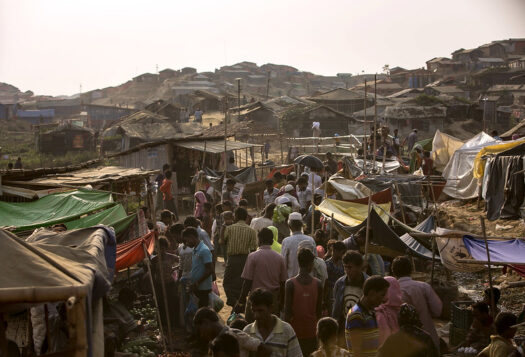
As Bangladesh embarks into 2020, the country stands at a critical juncture on its growth trajectory. Some of its key economic indicators went awry in the latter half of 2019, despite high growth numbers and projections. A boom in infrastructure investment, supported by competing geopolitical rivals continued to dictate the country’s development in 2019. In addition to signing seven new deals with India, Bangladesh has received fresh loans from China, the highest ever Official Development Assistance (ODA) from Japan, and an increased defense commitment from the United States under the Indo-Pacific Strategy. In 2019, various disasters headlined the country’s newspapers throughout the year, with two cyclones wreaking havoc on coastal regions, highlighting the grim impacts of climate change for the low-lying nation. The nexus of these economic setbacks, increased regional partnerships, and climate change issues have caused Bangladesh to step into 2020 with a note of caution as it prepares to graduate to middle-income status in 2024.
Economy and Development
Bangladesh’s economy has faced both growth and setbacks in 2019. It grew at an expected rate of 8 percent in 2019, which was the highest in Asia, beating behemoths like China and India. However, the sustainability of this growth has been put into question with certain key macroeconomic indicators going the other direction. Growth has not been inclusive, with latest data showing income inequality to be at its highest in recent times. Policies have not been conducive for low income earners either. In its most recent budget, the government proposed three additional Value Added Taxes (VAT), which will raise the price of essential goods for consumers. Additionally, inflation has been higher in Bangladesh than in most regional counterparts, which is perhaps best demonstrated by price of onions increasing five times over the course of October, 2019.
Together with other ongoing regional and global issues such as growth slump in India—a major trading partner which may consequently raise protectionist policies towards Bangladesh—whiffs of recession may be on the cards unless Bangladesh takes steps to diversify exports and shore up key economic sectors.
However, what is most disconcerting is the downward trend of the country’s year-on-year export earnings, which has fallen for the fourth consecutive month since August. This fall is largely caused by a poor performance from the apparel sector, the country’s major export earner. The sector accounts for 84 percent of the country’s total exports, while directly employing 3.6 million workers. Currency appreciation, and uncertainty regarding Brexit and the U.S.-China trade war have been some of the key reasons for this slump. If this trend continues, foreign reserves may take a hit and many of these low-skilled labors risk losing jobs with few other alternatives available. Together with other ongoing regional and global issues such as a growth slump in India—a major trading partner which may consequently raise protectionist policies towards Bangladesh—whiffs of recession may be in the cards unless Bangladesh takes steps to diversify exports and shore up key economic sectors.
On a more positive note, Bangladesh’s mega-development projects, such as Rooppur Nuclear Power Plant, Rampal Power Plant, Padma Bridge, and the Metro Rail Project, have been progressing according to expected schedules. These development projects and their sources of financing are major economic and political factors towards achieving Bangladesh’s growth aspirations, with the country requiring USD $320 billion by 2030 to finish these projects. However, various problems hinder progress, such as delays in signing of loan agreements, difficulties with land acquisition, and persistent bureaucracy. For example, despite China’s President Xi Jinping committing USD $20 billion towards Bangladesh’s development in 2016, only one-fourth of anticipated aid has come through so far. This sluggishness is due to red tape on both sides.
Bangladesh-India Relations
Although India-Bangladesh relations have been improving since Prime Minister Hasina took office in 2009, relations over the past year were shaken by India’s National Register of Citizens (NRC) in the northeastern state of Assam and its recent passage of the Citizenship Amendment Act (CAA). Many within Bangladesh were anxious over the potential impact of the NRC and CAA on their country, since public discourse in India during the Assam NRC generally equated “illegal immigrants” to “Bangladeshis.” Concerns among Indian Muslims over these processes saw many attempt to trespass into Bangladesh, with the Border Guards Bangladesh (BGB) detaining over 250 people in 15 days. To deter this influx, the Bangladesh government briefly shut down mobile networks on its borders. Although India has maintained that the NRC is an internal matter, Bangladesh’s stance on the issue has varied. When Prime Minister Hasina met with Indian Prime Minister Narendra Modi in October, she expressed concern over the process, however, more recently Bangladesh’s Foreign Minister Dr. A.K. Abdul Momen echoed that the NRC and CAA are India’s internal matters. Despite this, the general populace in Bangladesh is apprehensive of the possible impact within a country which is already struggling to maintain the Rohingya refugees.
Yet, 2019 also saw Bangladesh and India sign seven new agreements on a range of issues including coastal surveillance systems, cooperation in promoting youth and culture, and Indian use of the Chittagong and Mongla ports for transportation of goods. Although the relationship between the two neighboring nations has progressed swiftly in the last decade, some of these recent agreements were criticized in Bangladesh as the deals appear to cater to India. In particular, the deal to allow India to withdraw water from the Feni River was controversial, since Bangladesh continues to fail to get India to sign agreements on the Farakka Barrage dam and Teesta River water sharing.

Climate Risks
One of the most vulnerable countries to climate change, Bangladesh has been on the receiving end of multiple climate-induced catastrophes in 2019. Cyclone Fani hit the country in May, killing 17, destroying over 2,000 houses and 330 acres of crops, and altogether causing damages of around USD $63 million. This was followed by Cyclone Bulbul hitting the country in November, killing 25, severely affecting almost 14% of the country’s farmland, and causing damages worth USD $30 million. In addition, the country was hit by its worst Dengue outbreak in 2019 infecting nearly 30,000 people. This outbreak has been partially attributed to rising temperatures, since the mosquitoes that carry dengue are particularly sensitive to climate change.
Additionally, Prime Minister Hasina has expressed concern about the environmental impact of the Rohingya Refugee Crisis. Over 900,000 Rohingya refugees are currently residing in refugee camps in the low-lying coastal district of Cox’s Bazar, a region of Bangladesh which is expected to be one of the areas of South Asia to be most negatively impacted by climate change.
Additionally, Prime Minister Hasina has expressed concern about the environmental impact of the Rohingya Refugee Crisis. Over 900,000 Rohingya refugees are currently residing in refugee camps in the low-lying coastal district of Cox’s Bazar, a region of Bangladesh which is expected to be one of the areas of South Asia to be most negatively impacted by climate change. The immense deforestation, disappearing groundwater reserves, and increased air pollution in the areas in and surrounding the refugee camps has only served to increase concerns about the environmental footprint of the Rohingya Refugee Crisis. Efforts to rehouse Rohingya refugees in more sustainable, long term housing have hit snags however. Government efforts to move 100,000 Rohingya to the newly completed Bhasan Char housing project have been met with condemnation by some international human rights organizations who argue that the natural disaster prone island of Bhasan Char is unsuitable to house refugees. Further, many Rohingya’s has expressed their unwillingness to move there, similarly citing the inhabitability of the island—an idea government officials allege was begun by international aid workers. While the U.N. deliberates on the future of the Rohingya, U.N. bodies have shown reluctance towards moving the Rohingya, citing concerns over the lack of prior feasibility studies on the Bhashan Char housing project.
In response to these issues, Bangladesh put forward its concerns and demands on climate change in this year’s international Conference of Parties (COP) 25. Led by Prime Minister Sheikh Hasina, Bangladesh stressed the addition of a financing wing of the Warsaw International Mechanism (WIM) for loss and damages. The resultant creation of the Santiago Network on Loss and Damage was an important achievement for the country. Although the terms of financing were not agreed upon, this network will help broaden access to resources and finances for developing countries by improving the matching of a developing country’s needs and the resources available for averting, addressing, and minimizing losses due to climate change.
Bangladesh’s Critical Juncture
2019 bids Bangladesh farewell with a warning for the future, as the country approaches the end of its “Vision 2021” strategy—the first phase of the current government’s development plans. In 2024, Bangladesh is expected to graduate into a Middle-Income Country (MIC) at which point it will lose many of the economic benefits it currently enjoys. Standing at this critical juncture, cooperation with key economic partners and global allies is paramount for Bangladesh as it moves forward. However, Bangladesh also needs to work to ensure that climate change impacts do not undo this progress. As Bangladesh looks to achieve one of its highest growth rates in recent decades in 2020, several other key economic indicators render caution that this growth rate may be short lived. Unless the government takes concerted and effective measures, particularly in tackling governance issues that have been blighting the country since its inception, the economy may soon be in for a surprise, turning whiffs of recession into reality.
Editor’s Note: SAV contributors from across the subcontinent recap the most significant political, economic, and strategic developments in South Asia in 2019 and analyze what opportunities and challenges lie ahead for each country in 2020. Read the full series here.
***
Image 1: United Nations via Flickr
Image 2: Government of India


